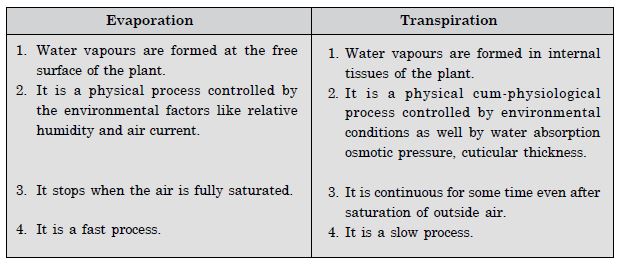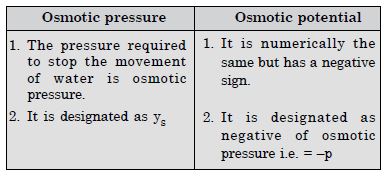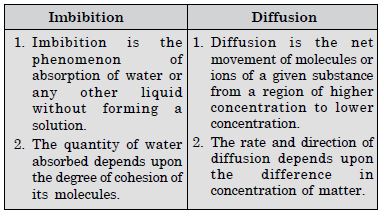Achieve excellent grades with NCERT Solutions available for free of cost at Aasoka. These solutions are extremely beneficial while preparing for your school exams as well as competitive exams. Students aspiring to pursue their career in JEE or NEET can take the advantage of NCERT Solutions for Class 11. The solutions are designed as per the latest CBSE syllabus to fulfill the student’s requirement of top educational resources.
In the chapter “Transport in Plant” of Class 11 Biology, students study topics like phloem, means of transport, transport: flow from source to sink, long-distance transport of water, plant-water relations, transpiration, active transportation, uptake and transport of mineral nutrients, osmosis, imbibing, plasmolysis, etc.
Question 1:
What are porins ? What role do they play in diffusion ?
Answer:
Porins. Certain proteins form channels in the membrane for molecules to pass through. The porins are proteins that form huge pores in the outer membranes of the plastids, mitochondria and some bacteria allowing molecules up to the size of small proteins to pass through during diffusion.
Role of Porins : These allow small sized molecules to pass through the membranes. The extracellular molecule binds to the transport protein. The transport protein then rotates and releases the molecule inside the cell. Water channels are made up of different types of aquaporins.
Question 2:
Describe the role played by protein pump during active transport in plants.
Answer:
Active transport uses energy ATP to pump molecules against a concentration gradient. Active transport is carried out by membrane-proteins. Hence different proteins in the membrane play a major role in active transport. Pumps are proteins that use energy to carry substances across the cell membrane. These pumps can transport substances from a low concentration to a high concentration (“uphill” transport). Transport rate reaches a maximum when all the protein transporters are being used or are saturated.
Question 3:
Explain why pure water has the maximum water potential.
Answer:
The difference between chemical potential of water at any point in a system and that of pure water under standard condition is termed water potential.
Water molecules possess kinetic energy. In liquid and gaseous form they are in random motion that is both rapid and constant. The greater the concentration of water in a system, the greater is its kinetic energy or its ‘water potential’. Hence it is obvious that pure water will have the greatest water potential.
Question 4:
Differentiate between the following :
- Diffusion and Osmosis
- Transpiration and Evaporation
- Osmotic Pressure and Osmotic Potential
- Imbibition and Diffusion
- Apoplast and Symplast pathways of absorption of water in plants
- Guttation and Transportation.
Answer:
- Differences between diffusion and osmosis
- Differences between evaporation and transpiration
- Differences between osmotic pressure and osmotic potential
- Differences between imbibition and diffusion
- Differences between apoplast pathway and symplast pathway
- Difference between guttation and transportation
Question 5:
What happens when a pressure greater than the atmospheric pressure is applied to pure water or a solution ?
Answer:
When a pressure greater than the atmospheric pressure is applied to pure water or solution, its water potential increases.
Question 6:
(a) With the help of well labelled diagrams, describe the process of plasmolysis in plants, giving appropriate examples.
(b) Explain what will happen to a plant cell if it is kept in a solution having higher water potential.
Answer:
(a) Plasmolysis. It occurs when water moves out of the cell and the cell membrane of a plant cell shrinks away from its cell wall.
This occurs when the cell (or tissue) is placed in a solution that is hypertonic (has more solutes) to the protoplasm. Water moves out it is first lost from the cytoplasm and then from the vacuole. The water when drawn out of the cell through diffusion into the extracellular (outside cell) fluid causes the protoplast to shrink away from the walls. The cell is said to to plasmolysed. The movement of water occurred across the membrane moving from an area of high water potential (i.e. the cell) to an area of lower water potential outside the cell.
Stages of plasmolysis in a plant cell
(b) If a plant cell is kept in a solution having higher water potential (hypotonic solution), water diffuses into the cell causing the cytoplasm to build up a pressure against the wall called the turgor pressure. The turgor pressure is ultimately responsible for enlargement and extensive growth of cells.
Question 7:
How is mycorrhizal association helpful in absorption of water and minerals in plants ?
Answer:
A mycorrhiza is symbiotic association of a fungus with a root system. The fungal filaments form a network around the young root or they penetrate the root cells. The hyphae have a very large surface area that absorb mineral ions and water from the soil from a much larger volume of soil that perhaps a root cannot do. The fungus provides minerals and water to the roots, in turn the roots provide sugars and N-containing compounds to the mycorrhizae. For example, Pinus seeds cannot germinate and establish without the presence of mycorrhizae.
Question 8:
What role does root pressure play in water movement in plants ?
Answer:
Root Pressure. During the absorption, water is forced into the xylem vessels by the surrounding cortical cells with a certain force. This induces a pressure which is responsible for ascent of sap to many feet in xylem. This pressure which is developed due to the metabolic activity of root is called as root pressure.
Root pressure is vital phenomenon helps in upward movement of water in herbaceous plants and depends upon activity of living roots cells. The magnitude of root pressure varies from 2-8 atm. Due to transpiration, hydrostatic pressure is built up in the xylem ducts, as a result water is pushed up the xylem ducts and out through hydathodes. This exuded water contains sugars, amino acids and salts. The root pressure is helpful for transport of water to the tips of herbaceous plants.
Question 9:
Describe transpiration pull model of water transport in plants.
Answer:
The transpiration pull model of water transport in plants is the most accepted model of water transport. The main features of this model are :
- Continuous water column. There is a continuous, uninterrupted water column of water from root through the stem and into the leaves. The water column is present in the tracheary elements.
- Cohesion and adhesion. It is a strong mutual force of attraction between the water molecules due to hydrogen bonds formed . On account of cohesion, the water column can bear a tension or a pull of large value.
Further, the water column does not break its connection with the tracheary elements because of another force called adhesion existing between their walls and water molecules. - Development of transpiration pull. Intercellular spaces present amongst mesophyll cells of the leaves are always saturated with water vapours. The latter come from the wet walls of mesophyll cells. The intercellular spaces of mesophyll are connected to the outside air through stomata. Outside air is seldom saturated with water vapours. It has a lower water potential than moist air present inside the leaf. Therefore water vapours diffuse out of the leaves. The mesophyll cells continue to lose water to the intercellular spaces. As a result their water potential also falls. The mesophyll cells withdraw water from the deeper cells. The deeper cells in turn obtain water from the tracheary elements. The water in the tracheary elements, would, therefore come under tension. Tension also develops in tracheary elements lying adjacent to the transpiring cells which causes the whole water column to come under tension. Since the tension develops due to transpiration, it is called transpiration pull. Due to this transpiration pull, the water column is pulled up passively from below to the top of the plant.
Question 10:
Discuss the factors responsible for ascent of sap in xylem plants.
Answer:
- Root Pressure. During the absorption, water is forced into the xylem vessels by the surrounding cortical cells with a certain force. This induces a pressure which is responsible for ascent of sap to many feet in xylem. This pressure which is developed due to the metabolic activity of root is called as root pressure.
- Cohesion. It is the mutual attraction between water molecules.
- Adhesion. It is the attraction of water molecules to polar surfaces.
Question 11:
What essential role does the root endodermis play during mineral absorption in plants ?
Answer:
The root endodermis cells have many transport proteins embedded in their plasma membranes that allow certain solutes to cross through them but not others. Such proteins act as control points where a plant adjusts the quantity and type of solute that it absorbs from the soil. Thus the root endodermis regulates the quantity and type of minerals and ions that reach the xylem.
Question 12:
Explain why xylem transport is unidirectional and phloem transport bi-directional ?
Answer:
The flow of water as a result of transpiration is only one-way whereas food in phloem sap can be transported in any direction needed so long as there is a source of sugar and a sink able to use, store or remove the sugar.
Thus xylem transport is always unidirectional whereas phloem transport is bidirectional as the source-sink relationship is variable depending upon the season or the need of the plant.
Question 13:
Explain pressure flow hypothesis of translocation of sugars in plants.
Answer:
The accepted mechanism used for the translocation of sugars from source to sink is called the pressure flow hypothesis. As glucose is prepared at the source (by photosynthesis for example) it is converted to sucrose (a dissacharide). The sugar is then moved in the form of sucrose into the companion cells and then into the living phloem sieve tube cells by active transport. This process of loading at the source produces a hypertonic condition in the phloem.
Water in the adjacent xylem moves into the phloem by osmosis. As osmotic pressure builds up the phloem sap will move to areas of lower pressure. At the sink osmotic pressure must be reduced. Again active transport is necessary to move the sucrose out of the phloem sap and into the cells which will use the sugar – converting it into energy, starch, or cellulose. As sugars are removed the osmotic pressure decreases and water moves out of the phloem.
Question 14:
What causes the opening and closing of guard cells of stomata during transpiration ?
Answer:
Opening and closing of stomata.
The opening and closing of stomata is controlled by the size and shape of guard cells resulting from the changes in their turgor.
The opening and closing of stomata is explained by an active potassium (K+) ion transport mechanism. The stomata open when the guard cells absorb K+ ions from the epidermal cells.
The uptake of K+ ions is balanced by the transport of H+ ions from the guard cells to the epidermal cells. The hydrogen ions (H+) appear in the guard cells due to dissociation of organic acids, particularly the malic acid. The latter dissociates into malate anion and H+ ions in the guard cells.







